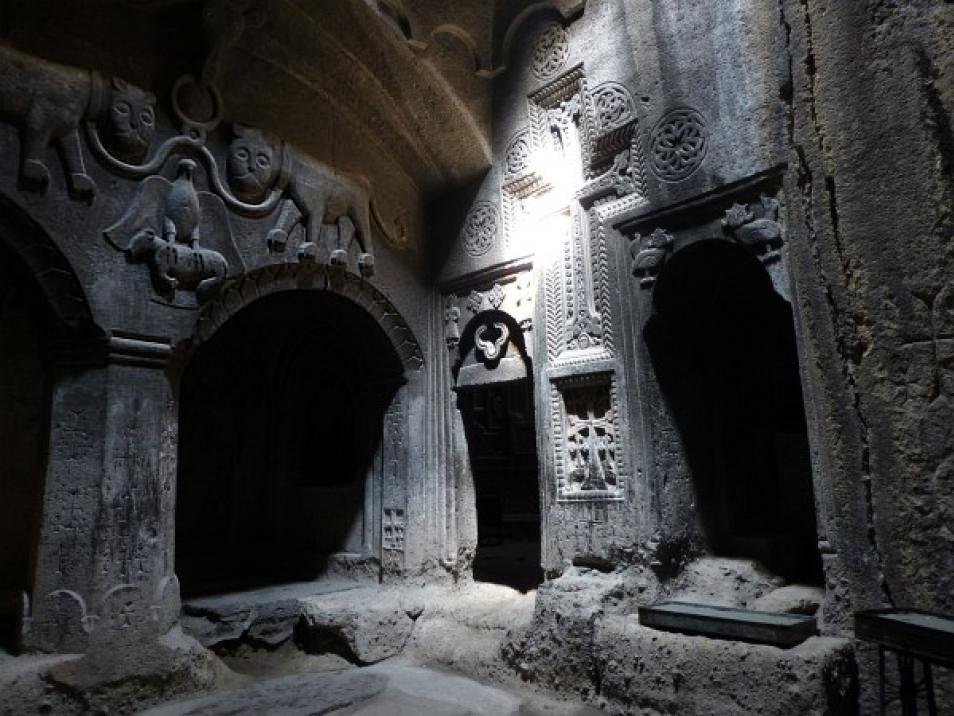MessageToEagle.com – Geghard is a fascinating ancient Armenian monastery located in the Kotayk province of Armenia and one of the country’s greatest spiritual and cultural centers.
The history of Geghard dates back to pre-Christian times and traditions that date back to ancient times when Armenians were influenced by the Persians and their Zoroastrian religion.

The monastery, partly carved out of the cliff rocks, is surrounded by high massive walls on three sides and the mountain on the fourth. Inside, there is a large number of chapels, which are interconnected and a maze of caves and secret rooms, tombs and khachkars (cross-stones) – outdoor steles carved from stone, which constitute an authentic Armenian form of art.
The main cathedral of cross-dome type was built in 1215, but legend has it that Geghard Monastery was founded in the 4th century. The first monastery at this site was called Ayrivank (‘Cave monastery’ or the ‘Monastery of the Caves’) but was burned down and plundered in 923.
The most ancient of the cave churches, St Gregory’s, dates back to the 7th century.
Later, in 10th-13th centuries it was renamed, after the holy lance that pierced Christ’s side at the crucifixion. In Armenian, Geghard means “spear” or “lance”).
According to legend, the apostle Thaddeus brought a spear to the Geghard Monastery and it was the same spear, which had wounded Christ on the Cross.
In 1240, Armenian prince Prosh bought the monastery and conducted there a series of extraordinary constructing works along with the subterranean part carved out of rock.
The earliest surviving part of the monastery, the Chapel of the Mother of God, dates from before 1164. Partly, this chapel is connected with passages and small rooms, fully, carved into the rock.
In total, surrounding the main site are more than 20 other rock-hewn chapels and service premises, many of which have carvings depicting a variety of animals, birds and flowers, as well as beautiful geometrical and floral patterns.
The southern facade has an interesting decoration in form of the prince Prosh’s a coat of arms (lion attacking an ox) of the family of the Zakarian prince who built it. The lion symbolizes royal might.
To the right of the entrance to the mausoleum, there are carved two sirens, mythical creatures with the crowned head of a woman and the body of a bird.
These creatures who lived on rocky islets off the coast of Sicily, lured men to their death, either by enchanting them with their singing so that they were shipwrecked on the rocks or, in some versions, by lulling the men to sleep with their singing so that the sirens could murder them while they slept.
The Geghard Monastery complex contains numerous, perhaps even hundreds of monk cells carved in the surrounding cliffs. The monastery had an ascetic tradition, and monks, who were originally hermits, lived, worked and prayed in the cells. Many of them did not leave their small quarters until they died.
‘Speaking Stones’ With Secrets – Remarkable Prehistoric Structures Of Karahunge, Armenia
Mysterious Lost Kingdom Of Urartu And Its Enigmatic History
The acoustics of the monastery’s chambers is impressive. One of the churches has been designed with the acoustics that produce a remarkable and mysterious sound, almost like a divine echo. The acoustics allowed the rooms to perfectly amplify monks’ chants when the monastery was in use.
Monastic cells and several small churches, cut out of the surrounding volcanic tuff, represent
an 11th-century feat of engineering and architecture of the Armenian masters.
MessageToEagle.com
Expand for references







